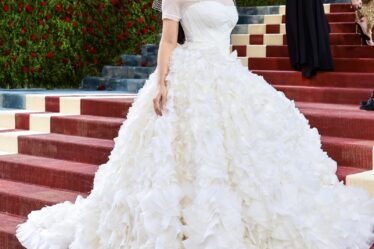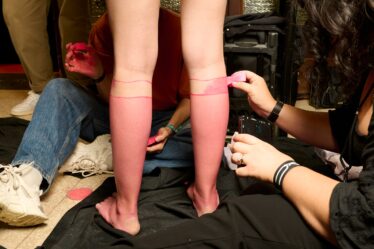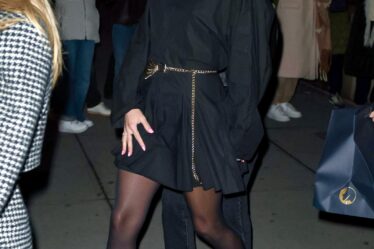
Like millions of parents around the world, Pragya Agarwal has spent countless rainy afternoons watching Frozen.
Back in 2013, when Disney first released its animated tale of two spirited princess sisters who definitely don’t need rescuing by any prince, she watched it with her now grownup eldest daughter. But it was her twin girls, now seven, who fell most deeply under the spell of Elsa, Anna and their magical ice kingdom. The girls have watched all the spin-offs, got the costumes, and though they’re starting to grow out of cartoons now, they still love rewatching Frozen; the whole family sings along lustily to its catchy big number, Let It Go, an epic power ballad about embracing your true nature and rejecting other people’s expectations. But their mother, a behaviour scientist and visiting professor at Loughborough University in Leicestershire, finds the song interesting on a different level.
“I’m reluctant to call it a feminist ballad but it is a little empowering to see that ‘I’m just going to let it rip – I’m not going to keep it all inside now or care about how you are supposed to mould yourself into these expectations and norms’ thing,” says Agarwal, whose recent book, Hysterical, investigates the gendering of emotion. “It’s about owning your power.” And that’s appealing not just to children, she points out: “We spend so much of our lives suppressing so many of our feelings, the things we want to say to people. It’s almost like that song gives us permission.”
It’s 10 years this month since the premiere of Frozen, which swiftly became the highest-grossing animated movie ever – a title it held for six years, until the Lion King remake came out, swiftly followed by the equally high-earning Frozen 2. Yet the original’s appeal remains undimmed.
Like Star Wars, it is not just a film but part of the cultural wallpaper, and a multi-billion-dollar global industry. Approximately 40 Frozen dolls are sold every minute, and that’s merely the tip of an iceberg of Frozen-branded Lego and Monopoly, bath bombs and lip balms, pyjamas and waffle makers. The film itself is a gateway drug to Disney’s theme parks and subscription-only TV channel, but also to ideas of what a princess should be. Even the real-life Princess of Wales once apologised, while on a visit in Cumbria, to a small Frozen fan disappointed to see her in jeans.
“It’s a cult,” groans a friend, whose two daughters have outgrown Frozen but whose job as a primary school teacher means she is greeted every World Book Day by a flock of mini-Elsas in shiny blue polyester. Another whose then six-year-old daughter was never into princesses says Frozen was the exception; even now, if she’s driving a posse of terrifyingly cool 16-year-old girls to a party, they’ll gleefully sing along to Let It Go. (When Taylor Swift covered the song live on stage in a 2015 duet with Idina Menzel, the actress who voiced Elsa, it was the crossing of two Gen Z cultural streams.)
The film has had its detractors, with blond, fair-skinned Elsa accused of reinforcing models of white beauty. (Agarwal, who is of Indian heritage, remembers a “big conversation” about the meaning of prettiness triggered by one of her tiny dark-haired daughters announcing she wanted yellow hair “because I want to be a princess and I want to be pretty”.) Frozen’s consciously feminist message, meanwhile, prompted the anti-woke Canadian philosopher Jordan Peterson to denounce it as “the subjugation of art to propaganda”. Yet for children who clamour to watch it on a loop, there’s clearly something compelling about a fairytale revolving less around romance than around a deep relationship millions immediately understand: the one they have with their siblings.
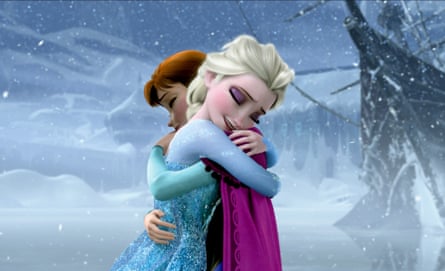
Frozen’s storyline is loosely based on The Snow Queen, Hans Christian Andersen’s fable about a wicked queen who steals a little boy, and the little girl whose love saves him. But Disney transformed its villain into sympathetic Elsa, born with the ability to shoot ice from her fingertips, and her nemesis into a devoted little sister, Anna. As a child, Elsa struggles to control her powers when angry or afraid, so her parents teach her to “conceal, not feel” emotions and to cover her hands in gloves. Having grown up hidden away in the royal palace, Elsa emerges at her coronation only to lose her temper with Anna, accidentally plunging the kingdom into eternal winter. Distraught, she flees into exile, and the day is eventually saved not by the apparent Prince Charming – who is swiftly exposed as a fraud – but by sisterly love. The film passes the feminist Bechdel test by having scenes where female characters talk to each other about something other than men. But more importantly, it speaks to children’s everyday experience.
Elsa’s storyline – accidentally hurting her sister, and being sent away for it – is instantly recognisable on a domestic level to any child banished to their room for fighting with a sibling, which may be why Frozen appeals to both sexes. But crucially, whatever Elsa does, Anna’s love never falters. For children grappling with the surprisingly murderous rage of the preschool years, watching Elsa struggle to tame her powers sends a reassuring message that you can experience intensely dark, angry feelings and still be loved. “It’s very comforting as a child who hasn’t learned emotional regulation,” says Agarwal. “It’s about big feelings in both the sisters, Elsa obviously but Anna as well – that you are not afraid to show big feelings, because often children are told: ‘Don’t scream’ or: ‘Don’t do this – these are bad emotions.’ It’s about saying that anger is not always destructive – it’s about how you manage and control it.”
Many children’s stories, she points out, feature one “good” character opposed to one who is evil. But Frozen is more nuanced: “Nobody’s completely good or bad; everybody has weaknesses and flaws. For children to see that you can make mistakes, you can be a little bit weird and still be OK – I think for children who feel that they are a little bit different from others, that’s comforting.”
If the plot is emotionally meaningful for children, however, it was also clearly written with their mothers in mind.
In 2011, the US journalist Peggy Orenstein’s bestselling book Cinderella Ate My Daughter captured an emerging backlash among 00s parents against the passive, often oddly sexualised ideas of femininity peddled to their daughters by major brands. A horrified Orenstein described how her two-year-old started nursery carrying a Thomas the Tank Engine lunchbox but was soon begging for a “real princess dress” and heels: “As if by osmosis, she had learned the names and gown colours of every Disney Princess. I didn’t even know what a Disney Princess was.” Readers wrote in saying they’d hate to have her as a mother but Orenstein struck a nerve with women who’d fought hard for their own careers and had no intention of raising miniature Cinderellas, waiting for their princes to come.
Meanwhile, in Britain, twin sisters Emma and Abi Moore co-founded the Pinkstinks campaign in 2008 against gender-stereotyped marketing to children, after comparing the messages Emma’s two daughters (then aged eight and four) and Abi’s young sons were absorbing from retailers who branded science kits as “for boys” while offering girls pink toy kitchens. Though their defiant “I’m no princess” T-shirts were popular with parents, it is the emails from children that stayed with Emma Moore. “I remember one, and it makes me well up just saying it, that said something like: ‘Because of what you’ve said it feels like it’s OK for me to be me now,’” she recalls. “She had never felt that way before – she had never been able to say, ‘I’m a bit different and that’s OK.’”
But sadly, Pinkstinks also got a frightening amount of hate mail from adults. “What we were saying was innocent stuff – it was that little girls can be more than just a princess, so please could we have some different ways of being a girl?” says Moore. “We couldn’t believe the vitriol, the things people said to us. And it wasn’t just blokes – it was women, too.” The challenge for a brand like Disney in such a climate, then, was to gently modernise its princesses without antagonising traditionalists.
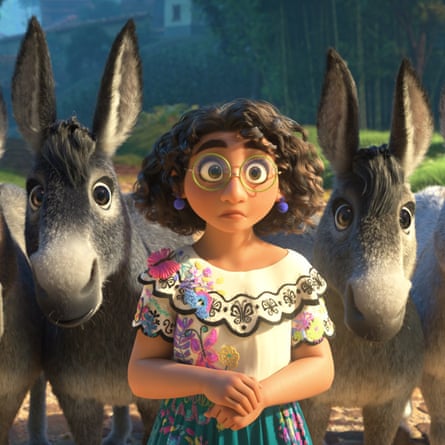
The result was Anna and Elsa, who may be thrillingly powerful – Anna gallops around on horseback fighting wolves, while Elsa can kill by pointing a finger – but still embody the improbably wasp-waisted, doe-eyed, swishy-skirted beauty of Disney’s 1930s Snow White. Little girls had to wait for the more athletic, brown-skinned 2016 Disney princess Moana or bespectacled Mirabel Madrigal in the 2021 film Encanto to see more realistic body shapes.
Yet the jury remains out on how exactly all this shaped an original Frozen generation now old enough to be sitting GCSEs. A 2016 study of three- to six-year-olds led by Sarah Coyne, professor of developmental psychology at Brigham Young University in Utah, seemingly confirmed some parents’ fears by finding that engaging with Disney princesses was associated with more gender-stereotypical behaviour in preschool girls – though it found no impact on their body image.
Five years later, Coyne, who kept in touch with her participants, published an update suggesting that consuming princess culture was now associated with having more progressive views, arguing that the effects could be changing over time. Citing stronger recent Disney heroines such as Elsa, Coyne suggested princess stories offered girls “key storylines where they’re the protagonist”, while boys exposed to them “tend to a do a better job expressing emotion in their relationships”. Admittedly, boys who see the film are likely to do so thanks to their sisters putting it on at home, and it’s hard to disentangle the effect of Frozen itself from the effect of having female siblings. But the films do offer boys an interesting lesson in who gets the girl.
Anna eventually falls for the supportive but not-so-alpha Kristoff – “a bit of a fixer-upper” as the trolls fondly describe him – after finding out that her dashing first love, Prince Hans, is a con man, taking advantage of her desperation to be loved. The warning not to believe in love at first sight is a strikingly grownup moment in the film, but one that nonetheless seemingly resonates with children. When Dr Sarah Godfrey, associate professor of film and television studies at the University of East Anglia, led a small study this summer of now adult Frozen fans about what they remembered of the film a decade on, she says almost all cited lessons learned from Prince Not-So-Charming.
“Quite a few of them spoke eloquently about Hans and his duplicitousness as being really instrumental in them becoming a bit more sceptical about that notion of true love, and so being more – not quite cynical, but certainly more wise perhaps than previous generations,” says Godfrey, who teaches Frozen as part of a degree module on gender in contemporary cinema. “It’s a really important message in the film and it’s interesting that even if they didn’t necessarily understand it in its nuance at the time, it’s stayed with them.”
Godfrey also points to the central appeal of Let It Go, a song that has come to mean very different things to very different people. Last year, footage of a seven-year-old girl singing it in a Ukrainian bomb shelter went viral, epitomising her country’s defiant resistance to the Russians. But it has also been widely adopted as a drag anthem and coming-out song.
The idea that Elsa might be a lesbian (despite having no love interest in the film) or even trans took off following a 2014 essay by the San Diego State University professor Angel Daniel Matos arguing for seeing her character through the lens of queer literary theory. The pressure from Elsa’s parents to hide her magical nature came to be interpreted as code for suppressing her sexuality, and her deep-frozen palace as a metaphorical closet.
Others, however, see the walls of ice between Elsa and the rest of the world as evidence that she is autistic, with her gloves a metaphor for “masking” socially unacceptable traits. One of Godfrey’s interviewees told her Elsa had helped him as a teenager “negotiating that question of belonging and kind of outsiderness”.
Whatever Elsa meant to individual children, her greatest legacy to the children’s entertainment industry may be proving the box-office value of strong female characters. Powerful female leads are now everywhere, from the Masters of the Universe character She-Ra to Marvel’s female avengers and Jodie Whittaker’s Doctor. Even Barbie was repositioned as a feminist heroine in Greta Gerwig’s hit 2023 film.
But none have yet quite rivalled Frozen in little girls’ affections, which is why the hype is already building inevitably around Frozen 3, expected in 2025. Few details are forthcoming, but for parents of small children, resistance is probably futile. Fed up of Frozen? Honestly, let it go.

